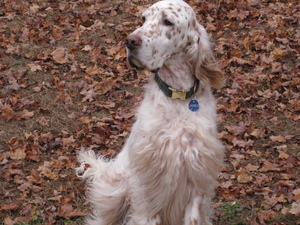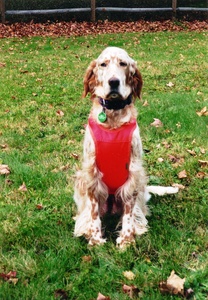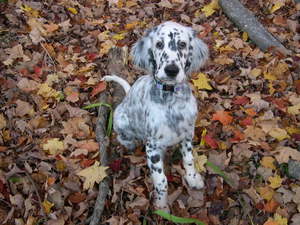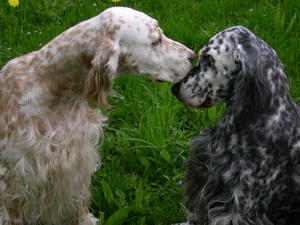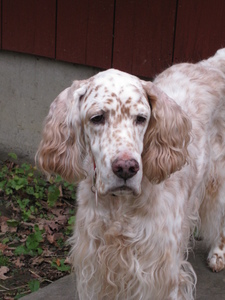James and I had a great visit today with the hospice patient we’ve been visiting weekly for the past five months. Usually she’s sitting in her wheelchair – and, due to her condition, she often has a hard time reaching James to pet him (we of course work very hard, James and I, to make it possible for her to touch his soft silky fur). Today, we found her lying in bed. She was quick to tell us that she wasn’t sick, they just wanted her to lie in bed to change her position. As always, she was delighted to see us – and was even more delighted when I had James get up on her bed, lie down along side of her and put his head on her chest. A broad smile appeared on her face. She was able to easily stroke his head and ears and talk to him face-to-face. Such a special visit!
What kind of training should my dog have to become a therapy dog?
As interest grows in the field of therapy dog visiting, the need for instruction has evolved. There are skills and techniques used by the handler and dog while visiting with patients, nursing home residents, children in educational environments, hospice patients, and other settings that, if learned ahead of time, can be very helpful and make visits more enjoyable for all involved.
Two years ago, I saw the need arise for such instruction and developed beginner and advanced classes designed to help those ready to embark on this type of volunteer work with their dogs. After having run the classes for two years, I’ve found that those who have attended are far more prepared for a therapy dog evaluation. They know what to expect.
The beginner class focuses on what makes a good therapy dog, and the beginner’s first and second steps in the training process. I start my classes by asking the participants the following three questions:
1) Has your dog ever shown signs of aggression?
2) Is your dog predictable?
3) Is your dog totally controllable?
The answer to #1 MUST be NO. A dog simply can not be a therapy dog if he or she shows signs of aggression toward people. This question must be answered honestly by the owner. You are responsible for your dog at all times and are liable for his or her behavior.
The answer to #2 MUST be YES. You, the dog’s owner, must be able to predict that your dog won’t bite someone, won’t bark incessantly while visiting a facility, won’t have an accident on the carpet when he or she gets excited, won’t jump up on someone’s lap uninvited or lick a patient’s face.
The answer to #3 is where the training comes in… we help teach you to train your dog to be totally controllable. This is your job. If you want to do this type of volunteering, you must work with your dog until you feel he or she is completely under your control. It’s really not work, it’s FUN! This is what builds the bond between you and your dog. A well-trained dog, is a happy dog. Dogs really want to please you. They want to know what’s expected of them by their owner.
Training starts with socialization. Socializing your dog is the most important thing you can do, whether you plan to do therapy dog visits or just want a happy, well-adjusted companion that’s not aggressive or timid when family and friends come to visit. See full discussion on socialization in: How best to prepare your puppy to be a therapy dog.
With the understanding that socializing your dog – puppy or adult – is key to building a successful relationship with your dog, and it’s something you do continuously throughout your dog’s life, we then move onto Basic Training.
The basic obedience commands of: sit, down, stay, come, heel must be solid – REALLY solid. This is where the training starts… and hopefully, you’ve already been working on these before coming to this class which focuses on the skills and techniques used in therapy dog visiting – which are beyond these basic commands. PRACTICE, PRACTICE, PRACTICE – all the time. Not just 20 minutes a day. Put your dog in a down-stay in front of his food dish, then tell him he can have it. Have your dog sit-stay before he can go through the open door. Take daily walks with your dog in heel position. This is not an exercise walk, this is a controlled walk-at-your-side walk. Make all this fun. And, don’t forget the treats, plenty of them. Your dog will LOVE the attention and direction you are giving him. When you feel you are ready to head out for a therapy dog evaluation, these basic commands must be solid. Your answer to question #3 – Is your dog totally controllable? must be YES.
How best to prepare your puppy to be a therapy dog
I’ve found through the years that some dogs are just naturals. Really, they were born to be therapy dogs. Others evolve into great therapy dogs. Some dogs – as wonderful as they are at home, are just not cut out to be therapy dogs. I’ve experienced all three – and in between – with my own dogs.
Starting your puppy off right gives you a good shot at working toward therapy dog certification. Socialization is key to having a puppy evolve into a dog that can go anywhere and meet and greet anyone. Beginning early is great: take rides in the car, walk with a friend who has a dog, go to a park – or other place where you’re sure to meet up with lots of people. Try to meet up with people of all ages… your dog must be socialized with children if you happen to want to do therapy dog visiting with that age group. Look for people in wheelchairs, walkers, and canes – go up and tell them that you are training your dog to be a therapy dog and ask them to pet your dog. The more you do this, the better off your dog will be – whether you pursue therapy dog work or just want a well-adjusted canine family member. I can’t stress this enough – and it’s the thing I bring up first at the start of every class I teach – What did you do this week to socialize your dog?
With everyone’s hectic schedules, I know it’s easier said then done, but it’s the most important thing you can do for your dog – and it helps to build a strong bond between you and your pal. It should be fun – not work – it’s part of having a dog. It should be part of your everyday living. If you are one of those lucky people who can bring your dog to work with you, this is a golden opportunity not to be missed. Definitely take advantage of this and have your dog interact with lots of people. If you work primarily out of a home office, as I do, the challenge is to get out… your dog isn’t going to get enough interaction from the mailman or the neighbor across the fence. Whatever your circumstances happen to be, it’s critical to your dog’s development that you work very hard on this first step.
When your canine family member dies
For those of us who care deeply about our canine companions, losing them is very difficult. The bond we have with our canine family members is very strong. It’s a connection that I consider to be magical… I’ve witnessed this magical connection between human and canine over and over again in the visits I’ve made over the past 18 years with my 5 therapy dogs. When our canine family member dies, we can feel very much alone. After all, it’s not a person that has died. Everyone understands that you’ll be sad if a person dies – a human family member – but a dog? I made the mistake once of telling a friend that I hadn’t gotten back in touch with her because my dog had died and I was very upset. She laughed….. yes, she actually laughed, said, Oh. Then proceeded to discuss whatever it was she had contacted me about. She has a dog, herself, so I figured she’d understand. Now – I am grateful to have many close dog friends with whom I can share my deep feelings of loss. They truly understand because they’ve been through it themselves.
Each time I lose a canine family member, I wonder if I can possibly go through the pain again. They never, ever live long enough. But, for me, life without a dog just isn’t an option. We are responsible in the end to be sure we don’t let our beloved dogs suffer. We are privileged to have the ability to end their suffering. What a shame it is that we can’t do the same for our human family members.
Honoring Julia’s memory
Three weeks ago, I found myself rushing to our Vet with Julia. I was getting ready to head to my office… I was in the midst of rallying the pack (then four) to head to their room. I noticed Julia having trouble – she was coughing up blood, once, then again, then four times within five minutes. I’m not one to call on the Vet for every little thing, but I knew this wasn’t a good sign… something was wrong. They had me bring her right in. Driving there, I kept trying to convince myself that it was something minor – something had caught in her throat, her stomach had been irritated by something she picked up in the woods. The Vet, too, chatted with me about minor things that could have happened – but then mentioned the dreaded word cancer. X-rays were needed. And, that’s what revealed the answer: a primary lung tumor that had spread throughout her entire body. Nothing could be done. Julia came home to spend the afternoon with her family – both human and canine. Then, at 6:00 that night, with her brother James and buddies Trudi and Annabelle encircling her, our Vet administered the injection that would send her into a peaceful, eternal sleep.
Julia was our dear canine family member, playmate of the pack, and a superb therapy dog. For several years, she soothed the lives of patients in a mental health unit at an area hospital. She could calm many a restless and unsettled patient with her exuberant, non-treatening, non-judgmental manner. The staff often mentioned that Julia’s weekly visits served to brighten the day for both patients and staff. The past two years, Julia has spent her time with rehab patients and residents at a local nursing home. She would first take a tour through the physical therapy room where she worked the room, stopping to visit with each of the ten or so patients there receiving service. At times, the physical therapists would have her assist in movement therapy. On down the hall she’d go making stops at rooms and residents sitting out in the hallways. Her last stop was always at her friend Nelly’s room. Nelly always had Julia jump up on her bed, she’d hug her and give her a special treat of pretzels.
This past Thursday, I made my first visit back to Linda Manor with Julia’s brother James. This wasn’t the first time I’ve had to do this… going to the facility and having to tell folks that their canine friend had died. This is a very hard part of the work I do. For years, the dogs visit, week after week, bringing comfort and caring to many who often receive limited contact from the outside world. And, then they are gone. Very hard, it doesn’t get any easier no matter how often it happens.
We are slowly adjusting to a pack of three – but a little piece of our heart broke off and went with Julia.
